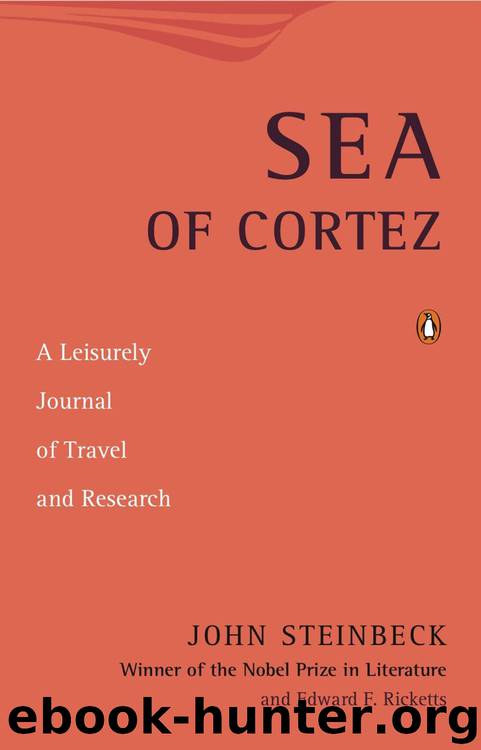Sea of Cortez;: A Leisurely Journal of Travel and Research, With a Scientific Appendix Comprising Materials for a Source Book on the Marine Animals of the Panamic Faunal Province, by John Steinbeck

Author:John Steinbeck
Language: eng
Format: mobi
Publisher: The Viking press
Published: 1941-04-15T08:00:00+00:00
17
March 27
WE HAD collected extensively on the outer parts of Puerto Escondido, but not in the inner bay itself. At five-thirty A.M. Mexican time, we set out to circle this inner bay in the little skiff. It was dark when we started, and we used the big flashlights for collecting. There was a good low tide, and we moved slowly along the shore, one rowing while the other inspected the bottom with the light. There was no ripple to distort the surface. The eastern shore was dominated by the big, flat, chocolate-brown holothurian.42 They moved slowly along, feeding on the bottom, many hundreds of them. They far overshadowed in number any other animals in this area. There were many of the ruffled clams 43 with hard, thick, wavy shells. The under-rock fauna was not very rich. The eastern and northern shores were littered with shattered rock, recently enough splintered so that the edges were still sharp, and in this quiet bay no waves would have ground the edges smooth. Mangroves bordered a great part of the bay, and the spicy smell of their flowers was strong and pleasant. A few of the giant, snake-like synaptids that we had taken in the outer bay waved and moved on the bottom. As we rounded toward the westerly side of the bay, we came to sand flats and a change of fauna, for the big brown cucumbers did not live here. The dawn came as we moved along the sand flats. Two animals were at the waterside, about as large as small collies, dark brown, with a cat-like walk. In the half-light we could not see them clearly, and as we came nearer they melted away through the mangroves. Possibly they were something like giant civet-cats. They had undoubtedly been fishing at the water’s edge. On the smooth sand bottom of this area there were clusters of knobbed, green coral (probably Porites porosa—no samples were gathered) , but except for Cerianthus and a few bivalves this bottom was comparatively sterile.
Rounding the southern end of the bay, we came again to the single narrow entrance where the water was rushing in on the returning tide, and here, suddenly, the area was incredibly rich in fauna. Here, where the water rushes in and out, bringing with it food and freshness, there was a remarkable gathering. Beautiful red and green cushion stars littered the rocky bottom. We found clusters of a solitary soft coral-like form 44 in great knobs and heads in one restricted location on the rocks. Caught against the rocks by the current was a very large pelagic coelenterate, in appearance like an anemone with long orange-pink tentacles, apparently not retractable. On picking him up we were badly stung. His nettle-cells were vicious, stinging even through the calluses of the palms, and hurting like a great many bee-stings. At this entrance also we took several giant sea-hares,45 a number of clams, and one small specimen of the clam-like hacha. For hours afterwards the sting of the anemone remained.
Download
This site does not store any files on its server. We only index and link to content provided by other sites. Please contact the content providers to delete copyright contents if any and email us, we'll remove relevant links or contents immediately.
How to Read Water: Clues and Patterns from Puddles to the Sea (Natural Navigation) by Tristan Gooley(2859)
Full Circle by Michael Palin(2774)
Into Thin Air by Jon Krakauer(2704)
How to Read Nature by Tristan Gooley(2666)
The Lost Art of Reading Nature's Signs by Tristan Gooley(2284)
In Patagonia by Bruce Chatwin(2273)
Don't Sleep, There Are Snakes by Daniel L. Everett(2218)
City of Djinns: a year in Delhi by William Dalrymple(2137)
L'Appart by David Lebovitz(2120)
The Songlines by Bruce Chatwin(2113)
Venice by Jan Morris(2051)
The Big Twitch by Sean Dooley(2044)
A Thousand Splendid Suns by Khaled Hosseini(1994)
Tokyo Geek's Guide: Manga, Anime, Gaming, Cosplay, Toys, Idols & More - The Ultimate Guide to Japan's Otaku Culture by Simone Gianni(1947)
A TIME OF GIFTS by Patrick Leigh Fermor(1849)
Come, Tell Me How You Live by Mallowan Agatha Christie(1769)
The Queen of Nothing by Holly Black(1757)
INTO THE WILD by Jon Krakauer(1725)
Iranian Rappers And Persian Porn by Maslin Jamie(1710)
